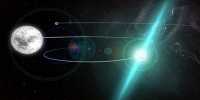A new experiment has shown that at pressure and temperature, the pure iron, like the lower part of the lining, will be thicker than the outer core. Earth’s magnetic field has long warned scientists that our planet has iron at its core. Explorations prove that the average density of other elements that exist in the outer core is lower than that of the fixed inner core.
The way an earthquake wave travels from an earthquake and hits the core of the earth reveals the existence of an internal and external core and allows us to estimate the density of each. Unfortunately, deep drilling to collect samples remains completely unrealistic, so the lab needs to be restructured to learn more about the original composition.
Professor Yasuhiro Kuwayama of the University of Tokyo said in a statement, which also ranks as quite an understatement, “It is not easy to restore the surface conditions here in the center of the earth.”We used a diamond anvil to compress a sample of liquid iron with intense heat. But we have to hold them longer to measure than to create the situation. That was the real challenge.”
At a pressure of 116 way gigapascals (about one million atmospheres) and 4,450 Kelvin (three-quarters of the Sun’s surface), Kuwayama allowed the team to search the sample with X-rays from Japan’s Spring-8 synchrotron. At these pressures, the concentration of pure liquid iron is 10 tons per cubic meter – 10 times the water in the house conditions. These results have been reported in the Physical Review Letter.
If the outer core were pure iron, the seismic waves would pass through it about 4 percent slower than them, Kuwayama proved, that its density was 8 percent lower than that of iron in the same situation. Although the impurities were expected, it is significant that they found fewer tendencies rather than increasing the average concentration.
Nickel is also thought to be abundant in the mainland but has a slightly higher concentration than liquid and solid iron. We do not yet know what other elements are in the core material, but Kuwayama’s work suggests that light must be abundant in contrast to the internal core that their presence is greater than that of nickel and all other dense elements.
Kuwayama added, “It’s important to investigate these things to understand more, not only about the Earth’s core, but about the composition, and thus behavior, of other planets as well.” Mercury and Mars also have iron cores initially, but some other elements are expected to be added.















